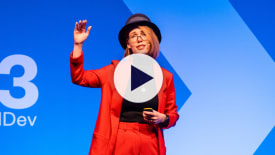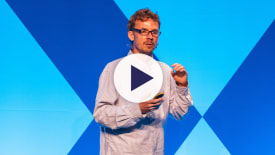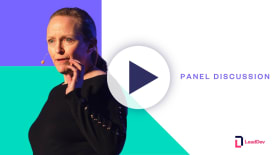
Latest videos
-
 In partnership with Harness
In partnership with HarnessAllow anyone to code with AI
How to build a culture that enables even the most skeptical developer to experiment with AI coding tools and fail fast.
-

How to lead when you just don’t know the tech
How to lead successfully in unfamiliar technical domains by embracing uncertainty, empowering teams, and still delivering results – even when you’re not the expert.
-

The lean architect: Experimenting your way to better decisions
Discover how hypothesis-driven architecture helps Staff+ engineers make better decisions early, reduce risk, and build resilient systems.
-

Becoming an AI Engineering company
Learn how to operationalize AI across your organization to drive innovation, improve efficiency, and stay ahead in a competitive market
-

The million dollar bug: Quality leadership lessons from costly failures
CrowdStrike lost $5.4B, Sonos stumbled into a $500M crisis – and they’re not alone. Learn battle-tested leadership strategies to protect your organization from quality catastrophes that can shake your business to its core.
-

Optimization of mobile development strategy for maximum business impact
Learn how to optimize mobile strategy—tech choices, team structure, and processes—for faster delivery, scalability, and measurable business results
-

Theory to action: Architecting and implementing your team operating system
Learn the theory behind the operating systems of high-performing engineering teams. Leave with a practical idea of how to design a flexible team operating system with rhythms, tools, and feedback loops for your team.
Highlights from our conferences

Measure for Change
Picking metrics is one thing. But the harder decisions lie in what to do with them afterward.
View all videos from LeadDev London

Drive product gaps as an engineering leader
Discover practical strategies for engineering leaders to influence product development effectively, even in the absence of strong product management and a clear company vision.
view all videos from LeadDev NEW YORK

Growth in a downturn
In this talk, Smruti Patel asks, if hyper-growth is marked by spending more to make more, what does building for enduring growth look like?
view all videos from LeadDev berlin

Idea to Innovation
Join me as we embark on a journey to dissect the anatomy of innovation, uncover strategies to unlock the full potential of ideas, and transform them into impactful realities. Let’s build a strong culture of innovation, and make sure that it is not just a buzzword but a tangible outcome.
view all videos from staffplus london

Slack enterprise key management: Senior to staff lessons
Explore the key lessons and skills Audrei gained during their first Staff+ project, Slack Enterprise Key Management. This talk offers insights for anyone growing in their Staff+ career.
view all videos from staffplus NEW YORK
All videos
-

Communicating change: leading through the change curve
How to tailor your communications based on how your employees are experiencing and reacting to the change.
-

Creating the foundation for difficult conversations
How to build and cultivate trust as the foundation for difficult conversations.
-

Forging the path to faster shipping in enterprise orgs
Working for large corporates doesn’t mean you have to live with slower shipping times.
-

Carving a modern engineering org out of an enterprise
Adopting best practices from tech-first companies
-

The engineering leader’s guide to motivational anti-patterns
Motivation mistakes and how to avoid them.
-

Coaching, sponsorship, and feedback in your organization
Reflections on developing others from across management levels and spheres of influence.
-

Running efficient, effective, and engaging retrospectives
Supercharging your team from one sprint to the next.
-
Universal Apps: Architecture for the Modern Web
“In today’s web environment, performance and Search Engine Optimization (SEO) are important to successful apps. Universal architecture provides a hybrid approach to building web apps that combines server-side rendered applications and Single-Page Applications (SPA). This architectural approach improves the user experience and makes it easier for your site to serve content to search and social bots.
This talk will explain the methodology and benefits of the universal approach. It will explore some of the tradeoffs and challenges that come with universal architecture. Finally, we will cover the various implementation options available today. At the end of this talk, you’ll be able to evaluate if universal architecture is a good choice for your projects.”
-
Traps on the Path to Microservices
After Netflix helped popularize microservices, you probably heard the architectural pattern labelled a boon. However, if your team is tasked with implementing the pattern it is too easy to find yourself in a place where you’ve significantly increased your architectural complexity without deriving any of the benefits that microservices purport to bring, especially if implemented without proper organizational maturity or careful foresight and follow-through.
ThoughtWorks has led many teams and organizations along the path from monoliths to microservices and this presentation covers three of the major traps that we’ve experienced (as well as how to avoid them). The traps covered are, underestimating the cost of a microservice, overcentralization, and neglecting the monolith
-
Traps on the Path to Microservices
After Netflix helped popularize microservices, you probably heard the architectural pattern labelled a boon. However, if your team is tasked with implementing the pattern it is too easy to find yourself in a place where you’ve significantly increased your architectural complexity without deriving any of the benefits that microservices purport to bring, especially if implemented without proper organizational maturity or careful foresight and follow-through.
ThoughtWorks has led many teams and organizations along the path from monoliths to microservices and this presentation covers three of the major traps that we’ve experienced (as well as how to avoid them). The traps covered are, underestimating the cost of a microservice, overcentralization, and neglecting the monolith
-

Designing effective criteria for assessing engineering candidates equitably
Unlock engineering talent through equitable hiring












